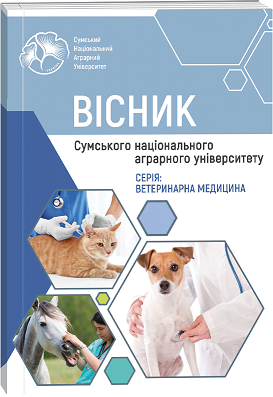INVASIVE PAPILLARY CARCINOMA OF THE MAMMA OF FELIS CATUS
Abstract
The most common type of breast cancer is invasive ductal carcinoma, which originates from the epithelial cells of the mammary ducts and subsequently infiltrates the surrounding breast tissue. If treatment is not started in a timely manner, invasive ductal carcinoma can metastasize to other organs and tissues (Wasserman J., 2023). Breast carcinomas in situ are malignant epithelial tumors that “do not have the property of spreading beyond the basement membrane into the connective tissue base of the breast” (Chocteau F. et al., 2019). According to WHO Breast 2019, the term insitu is used to refer to non-invasive histotypes of epithelial origin: tubular carcinoma in situ (LCIS), ductal carcinoma in situ (DCIS) including the papillary subtype, and solid papillary subtype (CIS) (Sasano H. et al., 2020). This type of neoplastic lesions is often accompanied by multicentric growth in the ducts of the mammary glands. The cells lack the polarity and morphological structure characteristic of epithelial cells (Misdorp W. et al., 1999; Goldschmidt M. et al., 2011). The prognosis for recovery from breast carcinoma is poor due to the fact that the metastasis rate is from 50% to 90%, with the lungs, lymph nodes, liver and pleura being the most affected (Petrucci G. et al., 2021; Chocteau, F. et al., 2019). The life expectancy of this species of animals with malignant breast tumors depends on the degree of aggressiveness of the tumor, the chosen mastectomy method and other factors. The life expectancy with tumors up to 3 cm in diameter is from 3 to 54 months; more than 3 cm in diameter is 12 months (Viste, J. R. et al., 2002). According to other data, these figures are, respectively, 2 years; 6 months (Seixas F. et al., 2007). In accordance with the above, the management of patients with malignant breast tumors requires a detailed analysis of the characteristics of the disease, the state of the body in order to adjust the treatment regimen to control the course of the pathological process, extend the terms and improve the quality of life of the animal. Clinical study (clinical examination of animals, morphological and biochemical blood tests), chest radiography and abdominal ultrasound were performed in the conditions of veterinary medicine clinics in Odessa. Pathomorphological study of breast tumors was conducted on the basis of the research laboratory of the Department of Normal and Pathological Morphology and Forensic Veterinary Medicine, Faculty of Veterinary Medicine, Odessa State Agrarian University.
References
2. Seixas F, Palmeira C, Pires MA, Lopes C. (2007) Mammary Invasive Micropapillary Carcinoma in Cats: Clinicopathologic Features and Nuclear DNA Content. VeterinaryPathology; 44(6):842-848. doi:10.1354/vp.44-6-842
3. Baba AI, Câtoi C. (2007) Comparative Oncology. Bucharest (RO): The Publishing House of the Romanian Academy; Chapter 11, MAMMARY GLAND TUMORS. Availablefrom: https://www.ncbi.nlm.nih.gov/books/NBK9542/
4. Borrego J. F., Cartagena J. C., Engel J. (2009) Treatment of feline mammary tumours using chemotherapy, surgery and a COX-2 inhibitor drug (meloxicam): a retrospective study of 23 cases (2002–2007). Veterinary and Comparative Oncology, v. 7, n. 4, p. 213-222
5. Cardiff Robert D. (2007) Comparative Pathology of Mammary Gland Cancers in Domestic and Wild Animals. Breast Disease, Vol. 28, No 1, P. 7–21. URL:https://content.iospress.com/articles/breast-disease/bd000258.
6. Chocteau F, Boulay MM, Besnard F, Valeau G, Loussouarn D, Nguyen F. (2019) Proposalfor a Histological Staging System of Mammary Carcinomas in Dogs and Cats. Part 2: Feline Mammary Carcinomas. Front Vet Sci. Nov 7;6:387. doi: 10.3389/fvets.2019.00387. PMID: 31788484; PMCID: PMC6856636.
7. Chocteau, F., Abadie, J., Loussouarn, D., Nguyen, F. (2019). Proposalfor a Histological Staging System of Mammary Carcinomasin Dog sand Cats. Part 1: Canine Mammary Carcinomas. Frontiers in veterinary science, 6, 388. https://doi.org/10.3389/fvets.2019.00388
8. Goldschmidt M, Peña L, Rasotto R, Zappulli V. (2011) Classification and grading of canine mammary tumors. Vet Pathol. 48(1):117-31. doi: 10.1177/0300985810393258. PMID: 21266722.
9. Horalsky L. P. (2005) Fundamentals of histological technique and morphofunctional research methods in normal and pathological conditions / L. P. Horalskyi, V. T. Khomych, O. AND. Kononskyi. Zhytomyr: Publishing house Zhytomyr. DAEU, 284 p.
10. Mcneill C. J., Sorenmo K. U., Shofer F. S., Gibeon L., Durham A. C., Barber L. G., Baez J. L., Overley B. (2009) Evaluation of adjuvant doxorubic in based chemotherapy for the treatment of feline mammary carcinoma. Journal of Veterinary Internal Medicine, v. 23, n. 1, p. 123-129.
11. Misdorp W., Else R. W., Hellman E. and Lipscomb T. P. (1999) Histological Classification of Mammary Tumors of the Dogand the Cat. Armed Forces Institute of Pathology, Washington DC, Vol. 7.P. 58. URL:https://www.scirp.org/reference/referencespapers?referenceid=648473
12. Misdorp W., Else R. W., Hellman E., Lipscomb T. P. (1999) Histological Classification of Mammary Tumors of the Dog and the Cat. Armed Forces Institute of Pathology, Washington DC, Vol. 7. P. 58.URL:https://www.scirp.org/reference/references papers?referenceid=648473
13. Mol, J. A., van Garderen, E., Selman, P. J., Wolfswinkel, J., Rijinberk, A., Rutteman, G. R. (1995). Growth hormone mRNA in mammary gland tumors of dogs and cats. The Journal of clinical in vestigation, 95(5), 2028–2034. https://doi.org/10.1172/JCI117888.
14. Morris J. (2013) Mammary tumours in the cat: sizematters, so early intervention saves lives. J Feline Med Surg. May;15(5):391-400. doi: 10.1177/1098612X13483237. PMID: 23603502; PMCID: PMC10816587.
15. Petrucci G, Henriques J, Gregório H, Vicente G, Prada J, Pires I, Lobo L, Medeiros R, Queiroga F. (2021) Metastatic feline mammary cancer: prognostic factors, outcome and comparis on of different treatment modalities – a retrospective multi centre study. J Feline Med Surg. 23(6):549-556.
16. Sasano H, Schnitt S, Sotiriou C, van Diest P, White VA, Lokuhetty D, Cree IA; (2020) WHO Classification of Tumours Editorial Board. The 2019 World Health Organization classification of tumours of the breast. Histopathology. 77(2):181-185. doi: 10.1111/his.14091. Epub 2020 Jul 29. PMID: 32056259.
17. Sorenmo Karin U. (2011) Canine Mammary Tumors: Clinical Features, Diagnostics and Staging. World Small Animal Veterinary Association held their 36 th World Congressin Jeju, Korea, URL:https://www.vin.com/doc/?id=5124313
18. Wasserman J. (2023) Invasive ductal carcinoma of the breast. URL: https://www.mypathology report.ca/diagnosis-library/breast-invasive-ductal-carcinoma/

 ISSN
ISSN  ISSN
ISSN 



